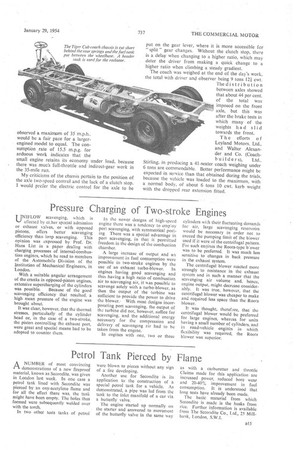Pressure Charging
Page 41

If you've noticed an error in this article please click here to report it so we can fix it.
of Two-stroke
Engines
UNIFLOW scavenging, which is effected by ei,her special admission or exhaust valves, or with opposed pistons, offers better scavenging efficiency than ionp scavenging. This opinion was expressed by Prof. Dr. Hans List in a paper dealing with charging processes of internal-combustion engines, which he read to members of the Automobile Division of the Institution of Mechanical Engineers, in London. With a suitable „angular arrangement of the cranks in opposed-piston engines, extensive supercharging of the cylinders
was possible, Because of the good scavenging efficiency that resulted, a high mean pressure of the engine was brought about.
It was clear, however, that the thermal stresses, particularly of the cylinder head or, in the case of a two-stroke, the piston controlling the exhaust port, were great and special means had to be adopted to counter them.
In the newer designs of high-speed engine there was a tendency to empOy port scavenging, with symmetrical porting There was a special advantage in port scavenging, in that it permitted freedom in the design of the combustion chamber. A large increase of output and an improvement in fuel consumption were possible in two-stroke engines by the
use of an exhaust turbo-blower. In engines having good scavenging and thus having a high ratio of combustion air to scavenging air, it was possible to scavenge solely with a turbo-blower, as then the output of the turbine was sufficient to provide the power to drive the blower.' With most designs incorporating port scavenging, the output of the turbine did not, however, suffice for scavenging, and the additional energy necessary for the compression and delivery of scavenging air had to be taken from the engine. In engines with one, two or three
cylinders with their fluctuating demands for air, large scavenging reservoirs would be necessary in order not to exceed the pumping limit of the blower used if it were of the centrifugal pattern. For such engines the Roots-type bower was to be preferred. It was much less sensitive to changes in back pressure in the exhaust system.
The centrifugal blower reacted more strongly to resistance in the exhaust system and in such a manner that the scavenging air volume and, hence, engine output, might decrease considerably. It was true, however, that the centrifugal blower was cheaper to make and required less space than the Roots blower.
It was thought, therefore, that the centrifugal blower would be preferred for large engines, whereas for units having a small number of cylinders, and in road-vehicle engin-es in which flexibility was required, the Roots blower was superior.












































































